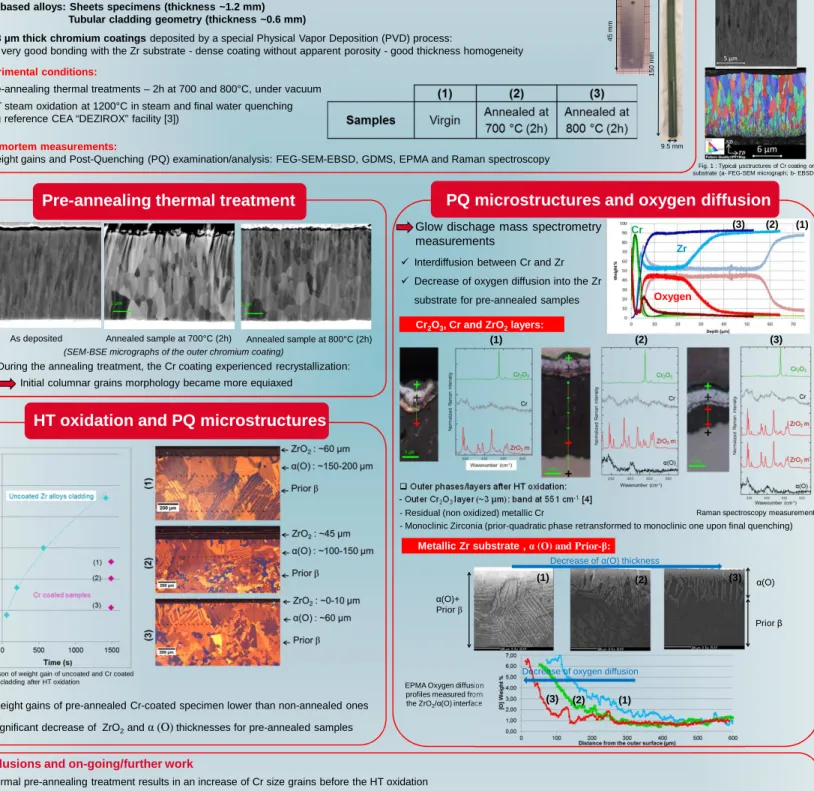HAL Id: cea-02394049
https://hal-cea.archives-ouvertes.fr/cea-02394049
Submitted on 21 Feb 2020
HAL is a multi-disciplinary open access
archive for the deposit and dissemination of
sci-entific research documents, whether they are
pub-lished or not. The documents may come from
teaching and research institutions in France or
abroad, or from public or private research centers.
L’archive ouverte pluridisciplinaire HAL, est
destinée au dépôt et à la diffusion de documents
scientifiques de niveau recherche, publiés ou non,
émanant des établissements d’enseignement et de
recherche français ou étrangers, des laboratoires
publics ou privés.
Effect of chromium grain size and morphology on the HT
oxidation behavior of chromium coated Zr based alloys
Nihed Chaabane-Jebali, Jean-Chistophe Brachet, Matthieu Le Saux, Didier
Hamon, Elodie Rouesne, Stéphane Urvoy, Thomas Guilbert, Michel Schlegel,
Michel Tabarant, Fernando Lomello
To cite this version:
Nihed Chaabane-Jebali, Jean-Chistophe Brachet, Matthieu Le Saux, Didier Hamon, Elodie Rouesne,
et al.. Effect of chromium grain size and morphology on the HT oxidation behavior of chromium coated
Zr based alloys. Materials Science and Engineering - session Structural Materials and Metallurgy, Feb
2019, San Francisco, United States. �cea-02394049�
Materials and experimental conditions:
Zr based alloys: Sheets specimens (thickness ~1.2 mm)Tubular cladding geometry (thickness ~0.6 mm)
6-8 µm thick chromium coatings deposited by a special Physical Vapor Deposition (PVD) process:
=> very good bonding with the Zr substrate - dense coating without apparent porosity - good thickness homogeneity
Experimental conditions:
1- Pre-annealing thermal treatments – 2h at 700 and 800°C, under vacuum 2- HT steam oxidation at 1200°C in steam and final water quenching
(using reference CEA “DEZIROX” facility [3])
Post-mortem measurements:
EFFECT OF CHROMIUM GRAIN SIZE AND MORPHOLOGY
ON HIGH TEMPERATURE STEAM OXIDATION BEHAVIOR
OF CHROMIUM COATED Zr BASED ALLOYS
Context:
Chromium coated zirconium based nuclear fuel claddings are developed and studied within the CEA-Framatome-EDF joint research program as “Enhanced Accident Tolerant Fuel” (EATF) cladding short-term concept for nuclear light water reactors [1] [2].Weight gains and Post-Quenching (PQ) examination/analysis: FEG-SEM-EBSD, GDMS, EPMA and Raman spectroscopy
Conclusions and on-going/further work
• Thermal pre-annealing treatment results in an increase of Cr size grains before the HT oxidation Weight gains of pre-annealed Cr-coated specimen were lower than the non-annealed ones.
Thickness of ZrO2and αZr(O) phases were significantly reduced for the pre-annealed samples, indicating that the grain size and morphological evolutions of the chromium coating
upon the pre-annealing thermal treatment may influence its further HT oxidation behavior, thus inducing: - Overall, higher resistance to HT oxydation
- Significant delay in the oxygen ingress into the Zr based substrate
• On-going: complementary EBSD, TEM... analysis for more detailed informations on the associated oxygen diffusion mechanisms...
Objective:
To investigate the influence of the initial chromium grain size and morphology on the High Temperature (HT) steam oxidation behavior of 6-8µm thick Cr-coated zirconium based specimens, by coupling several post-mortem experimental techniques, that is, FEG-SEM-EBSD, Glow discharge Mass Spectrometry (GDMS), Electron Probe Micro Analysis (EPMA) and Raman spectroscopy.Nihed Chaâbane
a, Jean-Christophe Brachet
b, Matthieu Le Saux
b, Didier Hamon
b, Elodie Rouesne
b, Stéphane Urvoy
b, Thomas Guilbert
bMichel Schlegel
c, Michel Tabarant
c,Fernando Lomello
c a INSTN, CEA, Université Paris-Saclay, F-91191, Gif-sur-Yvette, FrancebDEN, CEA, Université Paris-Saclay, Service de Rech. Métall. Appliquées, F-91191, Gif-sur-Yvette, France
b DEN, CEA, Université Paris-Saclay, Service d‘Etudes Analytiques et de Réactivité des Surfaces , F-91191, Gif-sur-Yvette, France
Comparison of weight gain of uncoated and Cr coated Zr alloys cladding after HT oxidation
Outer phases/layers after HT oxidation: - Outer Cr2O3 layer (~3 µm): band at 551 cm-1[4] - Residual (non oxidized) metallic Cr
- Monoclinic Zirconia (prior-quadratic phase retransformed to monoclinic one upon final quenching)
Pre-annealing thermal treatment
During the annealing treatment, the Cr coating experienced recrystallization: Initial columnar grains morphology became more equiaxed
Weight gains of pre-annealed Cr-coated specimen lower than non-annealed ones
Acknowledgments: Framatome and EDF for financial support and fruitful discussions Some references:
1. J.C. Brachet, et al., “Early studies on Cr-Coated Zircaloy-4 as Enhanced Accident Tolerant Nuclear Fuel Claddings for Light Water Reactors”, submitted to Journal of Nuclear Mat. (2019) 2. J. Bischoff, et al., "AREVA NP's Enhanced Accident Tolerant Fuel Developments: Focus on Cr-coated M5 Cladding", Nuclear Engineering and Technology 50, (2018), 223-2283
3. J.C. Brachet et al., “Mechanical behavior at Room Temperature and Metallurgical study of Low-Tin Zy-4 and M5™ alloys after oxidation at 1100°C and quenching”, IAEA-TECDOC-1320 (2001) 4. I. Idarraga, et al., “Raman investigation of pre- and post-breakaway oxide scales formed on Zircaloy-4 and M5R in air at high temperature”, Journal of Nuclear Mat. (2012) 421 – 160-171
1 µm 1 µm 1 µm
As deposited Annealed sample at 700°C (2h) Annealed sample at 800°C (2h)
EPMA Oxygen diffusion profiles measured from the ZrO2/α(O) interface
HT oxidation and PQ microstructures
Significant decrease of ZrO2and
α (O)
thicknesses for pre-annealed samplesGlow dischage mass spectrometry
measurements
Raman spectroscopy measurements 14 mm 4 5 m m 9.5 mm 1 5 0 m m
Fig. 1 : Typical µsctructures of Cr coating on Zr substrate (a- FEG-SEM micrograph; b- EBSD map)
Interdiffusion between Cr and Zr Decrease of oxygen diffusion into the Zr substrate for pre-annealed samples
(1) (2) (3) (3) (2) (1) Cr2O3, Cr and ZrO2layers:
Metallic Zr substrate , α(O) and Prior-β: Decrease of α(O) thickness
(1) (2) (3)
Decrease of oxygen diffusion α(O)+ Priorβ α(O) Prior β (1) (2) (3) Cr Zr Oxygen
(SEM-BSE micrographs of the outer chromium coating)
